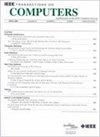Deep Learning Acceleration Optimization of Stress Boundary Value Problem Solvers
IF 3.6
2区 计算机科学
Q2 COMPUTER SCIENCE, HARDWARE & ARCHITECTURE
引用次数: 0
Abstract
The solution to boundary value problems is of great significance in industrial software applications. In this paper, we propose a novel deep learning method for simulating stress field distributions in simply supported beams, aiming to serve as a solver for stress boundary value problems. Our regression network, Stress-EA, utilizes the convolution encoder module and additive attention to accurately estimate the stress in the beam. By comparing the Stress-EA prediction results with the stress values calculated using ABAQUS, we achieve a mean absolute error (MAE) of less than 0.06. This indicates a high level of consistency between the stress values obtained from the two approaches. Moreover, the prediction time of Stress-EA is significantly shorter, taking only 0.0011s, compared to the calculation time of ABAQUS, which is 16.91s. This demonstrates the high accuracy and low computational latency of our model. Furthermore, our model exhibits smaller model parameters, requires less computation, and has a shorter prediction time compared to training results obtained using classic and advanced networks. To accelerate training, we utilize data parallel methods, achieving up to 1.89 speedup on a dual-GPU platform without compromising accuracy. This advancement enhances the computing efficiency for large-scale industrial software applications.深度学习加速优化应力边界值问题求解器
边界值问题的求解在工业软件应用中具有重要意义。在本文中,我们提出了一种模拟简支梁应力场分布的新型深度学习方法,旨在作为应力边界值问题的求解器。我们的回归网络 Stress-EA 利用卷积编码器模块和加法注意来准确估计梁中的应力。通过比较 Stress-EA 预测结果和使用 ABAQUS 计算的应力值,我们发现平均绝对误差 (MAE) 小于 0.06。这表明两种方法得出的应力值高度一致。此外,与 ABAQUS 的 16.91s 计算时间相比,Stress-EA 的预测时间大大缩短,仅为 0.0011s。这表明我们的模型具有高精度和低计算延迟的特点。此外,与使用经典网络和高级网络获得的训练结果相比,我们的模型显示出更小的模型参数、更少的计算量和更短的预测时间。为了加快训练速度,我们采用了数据并行方法,在双 GPU 平台上实现了高达 1.89 的速度提升,同时不影响准确性。这一进步提高了大规模工业软件应用的计算效率。
本文章由计算机程序翻译,如有差异,请以英文原文为准。
求助全文
约1分钟内获得全文
求助全文
来源期刊

IEEE Transactions on Computers
工程技术-工程:电子与电气
CiteScore
6.60
自引率
5.40%
发文量
199
审稿时长
6.0 months
期刊介绍:
The IEEE Transactions on Computers is a monthly publication with a wide distribution to researchers, developers, technical managers, and educators in the computer field. It publishes papers on research in areas of current interest to the readers. These areas include, but are not limited to, the following: a) computer organizations and architectures; b) operating systems, software systems, and communication protocols; c) real-time systems and embedded systems; d) digital devices, computer components, and interconnection networks; e) specification, design, prototyping, and testing methods and tools; f) performance, fault tolerance, reliability, security, and testability; g) case studies and experimental and theoretical evaluations; and h) new and important applications and trends.
 求助内容:
求助内容: 应助结果提醒方式:
应助结果提醒方式:


